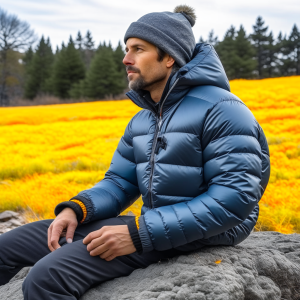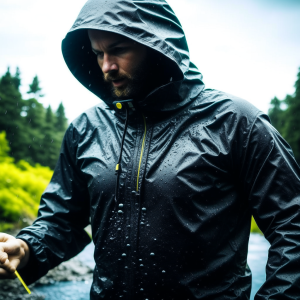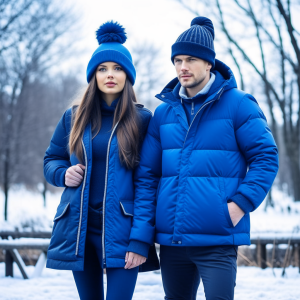Maximize Warmth and Style with Expert Layering Techniques for Cold Weather Clothing
As winter envelops us in its icy embrace, the dual challenge of staying warm while looking stylish becomes a top priority. The drop in temperatures necessitates a thoughtful approach to layering our clothing. Have you ever contemplated the intricate science behind effective layering? In this comprehensive guide, we will explore the principles that differentiate superior garments in the fight against the biting cold, ensuring that you remain both comfortable and chic throughout the winter season.
Layering is not just a fashion statement; it’s a strategic methodology for heat retention and comfort in frigid conditions. When the temperature falls, our bodies instinctively attempt to preserve warmth by constricting blood vessels, often resulting in cold extremities. However, this natural response may not suffice alone. This is where the art and science of layering become crucial, allowing us to create an effective barrier against the cold while maintaining freedom of movement and overall comfort.

Establishing Your Base Layer: The Essential Foundation for Winter Warmth
The base layer is the cornerstone of your winter wardrobe, designed to fit snugly against your skin while providing vital insulation. To fully appreciate the significance of this layer, we must delve into the science of moisture management and its profound influence on your warmth and comfort during the frigid months ahead. Understanding how this layer interacts with your body can significantly enhance your winter experience.
Utilizing Moisture-Wicking Fabrics for Superior Comfort
Choosing the right material for your base layer is essential for maximizing moisture management. The importance of moisture-wicking properties cannot be overstated. These specially engineered fabrics are designed to pull moisture away from your skin—whether it’s perspiration or external moisture—preventing accumulation that can lead to discomfort. A top-quality base layer not only acts as a moisture barrier but also keeps you dry and cozy, even under the most challenging weather conditions, vastly improving your overall warmth and comfort.
Enhancing Insulation: The Benefits of Merino Wool and Synthetic Fabrics
Let’s examine how materials like merino wool and synthetic fibers can enhance the insulating capabilities of your base layer. Merino wool is highly regarded for its natural warmth and breathability, making it an excellent choice as it provides insulation while effectively wicking moisture. In contrast, synthetic fabrics such as polyester and nylon offer a great balance of durability and insulation, creating a warm microclimate next to your skin that efficiently retains body heat, ensuring you stay cozy even in the most severe winter conditions.
Perfecting the Fit: Essential Tips for Base Layer Performance
Selecting the right fit for your base layer goes beyond simply picking your standard size; it’s about unlocking its full performance potential. A snug-fitting base layer maintains constant contact with your skin, enhancing both its insulating and moisture-wicking abilities. However, it’s vital to find the right balance—too tight can restrict movement and comfort, while too loose may diminish effectiveness. When selecting fit, consider your activity level and overall layering strategy to ensure seamless integration with your other winter garments.
In summary, the base layer is not just another piece of clothing; it functions as a sophisticated moisture-wicking and insulating barrier against harsh winter conditions. By understanding the unique properties of materials like merino wool and synthetic fibers, along with mastering the fit, you can elevate your base layer from a simple article of clothing to a crucial element of your defense against the cold.
Leveraging the Insulating Layer: Your Key to Retaining Body Heat
 As we turn our attention to the insulating layer, we recognize its essential role in capturing and retaining heat around your body. This layer is critical in the science of heat retention, acting as a protective cocoon against harsh winter elements. We will explore fundamental aspects like warmth-to-weight ratios, the benefits of down insulation, and the eco-friendly advantages of synthetic alternatives that contribute to your warmth and comfort.
As we turn our attention to the insulating layer, we recognize its essential role in capturing and retaining heat around your body. This layer is critical in the science of heat retention, acting as a protective cocoon against harsh winter elements. We will explore fundamental aspects like warmth-to-weight ratios, the benefits of down insulation, and the eco-friendly advantages of synthetic alternatives that contribute to your warmth and comfort.
Deciphering Warmth-to-Weight Ratios for Effective Insulation
Understanding warmth-to-weight ratios is crucial when selecting an insulating layer. This principle highlights that insulation materials should deliver exceptional warmth without adding unnecessary bulk. Essentially, it’s about maximizing warmth while minimizing weight, ensuring you can move freely and comfortably. This balance is particularly important for those who desire insulation without feeling burdened, allowing for unrestricted movement in cold environments.
Down Insulation: Lightweight Warmth for the Adventurous
Down insulation is a premier choice for those seeking unparalleled warmth in a lightweight form. Sourced from the soft feathers of ducks and geese, down is famous for its remarkable warmth-to-weight ratio. Its lightweight and compressible characteristics make it a favorite among winter adventurers who need effective insulation without sacrificing mobility. Appreciating the unique benefits of down insulation is key to understanding its integral role in creating an insulating layer that seamlessly combines warmth, comfort, and flexibility.
Choosing Synthetic Insulation: Ethical Warmth for All Conditions
Synthetic insulation materials, primarily composed of polyester fibers, have become popular ethical alternatives in the insulation landscape. What sets synthetic insulation apart is its ability to retain heat even in wet conditions, a performance area where down may falter. This durability in unpredictable weather makes synthetic options ideal for a variety of climates. Additionally, selecting synthetic materials aligns with ethical considerations, allowing you to enjoy warmth without compromising your values regarding animal welfare.
Precision in Thickness Selection: Tailoring Insulation to Your Needs
Choosing the appropriate thickness for your insulating layer requires careful consideration; precision is key. Evaluate the expected level of cold exposure alongside your layering strategy when determining thickness. In milder climates, a thinner insulating layer may suffice, while harsher conditions may demand a thicker, more robust option. By comprehending the nuances of insulation thickness, you can customize your insulating layer to meet the specific requirements of your winter activities.
Ultimately, the insulating layer transcends traditional clothing roles, emerging as a strategic ally in the battle against cold. By understanding warmth-to-weight ratios, celebrating the benefits of down insulation alongside synthetic options, and providing guidance on thickness selection, we can redefine the insulating layer as a calculated defense mechanism against winter’s icy grasp.
Your Outermost Layer: The Ultimate Defense Against Winter’s Harsh Elements
The outermost layer acts as your essential barrier against biting winds and freezing temperatures. This layer serves two primary purposes: it protects against environmental elements and plays a significant role in moisture control. As we explore the outer layer more deeply, we will reveal the importance of breathability, the transformative benefits of DWR finishes and Gore-Tex membranes, and the crucial windproof features that enhance insulation efficiency.
Breathability: A Fundamental Aspect of Comfort and Moisture Management
Often underestimated, breathability is a crucial characteristic of the outer layer that greatly influences overall comfort. This feature refers to the fabric’s capacity to allow sweat vapor to escape your body while preventing external moisture from penetrating. Achieving this delicate balance keeps you dry and comfortable, thus mitigating the chilling effects of trapped moisture. A breathable outer layer is essential for maintaining a cozy microclimate within your clothing, ensuring exceptional comfort during inclement weather.
Understanding DWR Finishes and Gore-Tex: Top-Tier Waterproofing Innovations
 DWR (Durable Water Repellent) coatings and Gore-Tex membranes are at the forefront of cold-weather outerwear technology. DWR finishes provide fabrics with water-repellent properties, creating an effective barrier against rain, sleet, and snow. Gore-Tex and similar technologies elevate waterproofing to unprecedented levels by combining impermeability with breathability. Understanding how these technologies work in concert is vital for staying dry and comfortable, even in the harshest weather conditions.
DWR (Durable Water Repellent) coatings and Gore-Tex membranes are at the forefront of cold-weather outerwear technology. DWR finishes provide fabrics with water-repellent properties, creating an effective barrier against rain, sleet, and snow. Gore-Tex and similar technologies elevate waterproofing to unprecedented levels by combining impermeability with breathability. Understanding how these technologies work in concert is vital for staying dry and comfortable, even in the harshest weather conditions.
Windproof Features: Strengthening Your Protection Against Cold Winds
Windproof characteristics are indispensable in frigid weather, especially when biting gusts can permeate even the sturdiest fabrics. The windproof outer layer provides an impenetrable shield against cold air, enhancing comfort while preserving the insulation of the inner layers. By blocking icy winds, your outer layer transforms into a formidable protector, ensuring that your carefully curated layers function cohesively to keep you warm and shielded from severe elements.
In essence, the outermost layer is more than a protective shell; it is an advanced barrier that expertly balances breathability with waterproofing. By recognizing the significance of breathability, exploring the innovations of DWR finishes and Gore-Tex membranes, and appreciating the indispensable role of windproof features, we can elevate the outer layer into a dynamic garment that excels in style, functionality, and weather resistance.
Effective Strategies for Blending Maximum Warmth with Style This Winter
With a solid grasp of effective layering techniques established, let’s explore actionable tips and strategies to enhance your cold-weather experience, seamlessly blending warmth with enduring style. Accessories play a critical role in winter attire, often serving as unsung heroes that can completely transform your look. From the vital warmth provided by carefully selected gloves to the fashionable flair of a cozy hat and the comfort of thermal socks, these seemingly minor details significantly contribute to crafting a fashionable and comfortable winter ensemble.
The Indispensable Role of Accessories: More Than Just Aesthetic Appeal
Accessories serve a purpose far beyond mere decoration; they are essential elements of your defense against the cold. Beyond their visual charm, items such as gloves, hats, and thermal socks perform critical functions in enhancing your overall warmth. By thoughtfully incorporating these accessories into your winter wardrobe, you can ensure that every part of your body is shielded from the chill, effectively preventing valuable body heat from escaping into the frigid air.
Investing in Quality Accessories: Recommendations for Ultimate Comfort
The search for warmth extends beyond your base and insulating layers; it also includes the careful selection of accessories. Invest in high-quality gloves crafted from insulating materials like fleece or lined leather to create a robust barrier against the cold. A warm hat featuring additional insulation or a cozy faux-fur lining not only looks chic but also aids in heat retention. Opt for thermal socks made from merino wool or advanced synthetic blends to ensure maximum warmth and effective moisture management, keeping your feet cozy all winter long.
Style Tips: Merging Functionality with Fashion
Staying warm during freezing temperatures doesn’t have to compromise your sense of style. Utilize these clever styling techniques to navigate the winter landscape gracefully. Experiment with layering different textures in your outfit to create visual interest while simultaneously enhancing insulation. Choose winter-appropriate colors that harmonize with the snowy environment, and don’t hesitate to accessorize with bold pieces like a vibrant scarf or chic earmuffs to elevate your overall look and make a statement.
Ultimately, accessories are the understated architects of a well-rounded winter outfit. They not only enhance warmth but also allow you to express your personal style even in the coldest conditions. By selecting high-quality accessories and infusing your winter wardrobe with thoughtful styling, you can master the chill while showcasing undeniable elegance.
Embrace the Harmony of Style and Functionality in Your Winter Wardrobe
As we conclude our exploration of conquering the cold, it’s vital to acknowledge the significance of style in winter clothing. Dressing for the cold doesn’t mean sacrificing your fashion sense; rather, today’s fashion landscape celebrates the seamless integration of functionality and flair. Numerous outdoor and fashion brands have recognized and embraced the demand for winter gear that not only keeps you warm but also exudes confidence and contemporary elegance.
The Evolution of Cold-Weather Apparel: A Stylish New Era
 The cold-weather clothing industry is experiencing a renaissance, where winter gear transcends mere functionality to become a symbol of innovation and style. Designers and brands are increasingly recognizing the need for clothing that seamlessly blends practicality with aesthetic appeal. This evolution has ushered in a new era of outerwear that not only provides warmth but also captivates with its visual allure and sophisticated design.
The cold-weather clothing industry is experiencing a renaissance, where winter gear transcends mere functionality to become a symbol of innovation and style. Designers and brands are increasingly recognizing the need for clothing that seamlessly blends practicality with aesthetic appeal. This evolution has ushered in a new era of outerwear that not only provides warmth but also captivates with its visual allure and sophisticated design.
Leading Brands: Merging Fashion with Functionality
Several brands are at the forefront of this style revolution, skillfully combining fashion and functionality in their winter apparel. Canada Goose is celebrated for its luxurious down coats that offer remarkable warmth without compromising style. The North Face integrates cutting-edge technology into its designs, crafting outerwear that balances chic aesthetics with practical functionality. Meanwhile, Moncler has redefined the puffer jacket, transforming it into a high-fashion statement piece, demonstrating that winter clothing can be both practical and runway-ready.
Mastering Winter Fashion: Elevate Your Style Game
Now, let’s delve into how to effectively merge warmth and style in your winter outfits. Choose standout pieces that fulfill both functional and aesthetic roles, such as a beautifully tailored wool coat or a sleek parka that serves as the centerpiece of your ensemble. Experiment with layering a chunky knit sweater over a fitted jacket for a cozy yet stylish appearance. Don’t hesitate to introduce vibrant colors into your winter look by accessorizing with eye-catching scarves or trendy boots that capture attention and enhance your overall outfit.
Ultimately, embracing style in the cold is no longer a contradiction; it’s a vibrant reality shaped by a dynamic fashion industry. As fashionable cold-weather gear emerges, adorned by innovative brands, the narrative shifts from mere survival to personal expression. So, immerse yourself in this style renaissance, choose pieces that empower you, and push the boundaries of fashion amid the wintry embrace of the season.
The post Cold Weather Clothing Layers: The Science Explained appeared first on Survival Bite.
The Article Cold Weather Clothing Layers Explained: Understanding the Science Was Found On https://limitsofstrategy.com


This discussion on layering is particularly timely; as someone who often struggles with the balancing act of staying warm and looking presentable during colder months, I appreciate the insight into the science behind it. I’ve found that investing in quality base layers really makes a difference, especially those made from materials like merino wool or high-performance synthetics. They not only wick moisture away but also provide a surprising amount of warmth without the bulk that can so easily compromise style.
I completely get where you’re coming from with the struggle of balancing warmth and style during the colder months. It feels like a constant challenge every winter. Investing in quality base layers really is a game changer. I remember switching to merino wool a couple of years ago, and it seriously changed my entire outlook on layering. Not only does it keep you warm without that thick, bulky feeling, but it also has this natural breathability that helps regulate your body temperature.
I can really relate to what you’re saying about the struggle of finding that sweet spot between warmth and style. Winter can feel like a fashion puzzle where the pieces just don’t seem to fit sometimes. It’s one of those seasons that forces us to rethink our wardrobe choices, especially when it’s chilly out.
It’s interesting how much layering really impacts our winter experience. Your point about quality base layers is spot on. Merino wool and high-performance synthetics are definitely game changers. They manage to keep you cozy while feeling almost invisible under your clothes.
I couldn’t agree more about the role layering plays in our winter experience. It truly changes how we engage with the season. Merino wool has been a staple for me; the way it regulates temperature and wicks moisture makes it hard to go back to anything else. And you’re right about the synthetics—they can feel almost like a second skin, which is perfect for those days when you’re active outdoors.
You’ve hit the nail on the head with the importance of layering in how we experience winter. It’s fascinating how something as simple as choosing the right fabrics can transform our time outdoors. Merino wool really is something special. The way it manages temperature is a game changer—whether you’re out for a winter hike or just running errands, it keeps you comfortable without overheating. I love how it still feels soft and cozy against the skin, which is a big plus compared to some other materials that can feel scratchy.
You raised a great point about layering. It’s remarkable how something so basic can significantly enhance our experience, especially in winter. I keep coming back to merino wool, too. It’s impressive how it balances warmth and breathability so well. I remember the first time I wore a merino base layer while skiing; I didn’t realize how much of a difference the right fabric could make. No more sweaty, chilly moments halfway down the slope.
I completely resonate with your thoughts on layering—it’s such an art form, isn’t it? It really can transform how we experience winter. Merino wool is a game-changer for those chilly months; I love how versatile it is. I’ve found it to be both super comfortable and surprisingly effective at keeping me warm without overheating. It’s become a favorite for those long hikes when I want to stay active but not turn into a sweaty mess.
I completely share your perspective on layering—it really transforms how we experience winter. I’ve also found that merino wool is unbeatable for maintaining comfort, especially on those long hikes when temperatures can fluctuate so much. There’s something almost meditative about being outdoors in the cold, knowing your gear is working with your body rather than against it.
It’s great to hear your perspective on layering and the importance of choosing the right materials. You’re spot on about the role of quality base layers in striking that balance between warmth and style. Merino wool, for instance, has so many unique properties that go beyond just comfort. It’s naturally breathable and helps to regulate body temperature, which is crucial when you transition between outdoor chill and indoor warmth.
I really appreciate how you’ve highlighted the significance of layering—not just from a style perspective, but also for warmth and comfort during the cold months. It’s so easy to forget that what we wear can directly influence how we feel, especially as winter drags on and icy winds become a daily hassle.